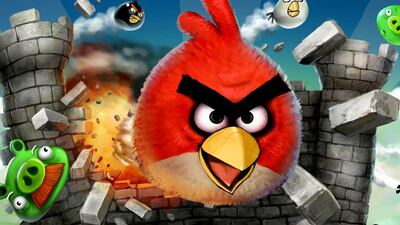They are free to download, fun to play and fiendishly addictive: mobile games such as Candy Crush Saga, Angry Birds and Clash of Clans want to get you hooked, then get your money.
Whether you are paying to obtain extra lives, to buy “gems” to use as a virtual currency or just to carry on playing without delay, the “freemium” games boom is a money-spinner for the most successful developers.
In-app purchases helped to drive up spending on mobile games by more than 60 per cent to US$16.5 billion (Dh60.6bn) in 2013, according to figures released by the research house IHS released ahead of last week’s World Mobile Congress in Barcelona, Spain.
“What we have done is bring the thought processes and skills of selling and marketing more clearly into the game,” says Nicholas Lovell, the author of The Curve, a book about making money in a world of free digital content.
In any given month, only about one in 20 players of a given “freemium” game makes an in-app purchase, Lovell says, meaning the most devoted end up paying the most, while others enjoy it for free.
“If you are heavily invested in a game world and you are putting your emotions and your friendships in that game world then the psychology can become a lot more powerful,” he says.
Once a player has downloaded a free game, the holy grail of designers is to keep him or her playing, hopefully with various 10-20 minute bouts in a day and a longer session or two in the evening.
The most committed players are the most likely to spend, says Lovell, who is also the founder of Gamesbrief, a blog that advises games developers on business strategy.
For example, a player may pay to avoid waiting 24 hours before advancing to a key goal. Then there is the chance to avoid “the grind”. A player might need 10,000 gold coins to obtain a crucial object, requiring the completion of 1,000 quests, each of which earns 10 coins.
Within a freemium mobile game, you can spend weeks to complete the “grind” of 1,000 quests – or just pay some money to avoid the task altogether. “That devalues it in some people’s eyes. It is not evil. It is annoying if you are the kind of person who thinks like that,” Lovell says.
The industry expert welcomes new principles released by the Office of Fair Trading in the United Kingdom, to ensure parents authorise children’s in-app purchases and to prevent unfair and aggressive sales techniques to which minors may be susceptible. This week, a case was reported in Britain involving a 12-year-old who unwittingly ran up a bill of almost £2,500 (Dh15,300) buying “jewels” in-app for a handset game.
Apple and others should introduce a child mode that lets parents block unauthorised activities on their smartphones and tablets, Lovell says. Nevertheless, he believes variable pricing will become a model for all digital content, not just games.
Brian Blau, an analyst at the technology research company Gartner Inc, says consumers are making in-app purchases simply because they want to play games.
“There is a certain amount of that addictive gambling type psychology about it, but for the most part people just want to play the game. They like it,” Blau says. “There is nothing tricky about it. The thing is that you want to play the game.”
For a minority, however, the video gaming world can become addictive. Video games use “operant conditioning” to reward players for certain behaviours, says Emil Hodzic, a psychologist who runs a clinic treating video game addiction in Sydney, Australia.
“For example, you get a reward every time you hit your enemy with a sword,” he says. “But as time goes on, those rewards get stretched further and further apart. The person ends up spending more time for less reward. In the meantime, it builds up higher levels of anticipation.”
Hodzic, whose clients are mostly ages 14-21, says children enjoy the reward of such video games but can struggle to self-regulate and risk getting into difficulty if their parents are not aware.
Some games, though only a minority, instil an “atmosphere of fear”, he says, almost bombarding players with messages that, for example, offer “special rates” to get 10,000 gems to upgrade and protect a newly constructed castle.
Parents need to ensure their children keep their feet in the real world, Hodzic says. “In terms of things to look out for, you want to be sure that their face-to-face world is not shrinking as their online world is increasing.”

